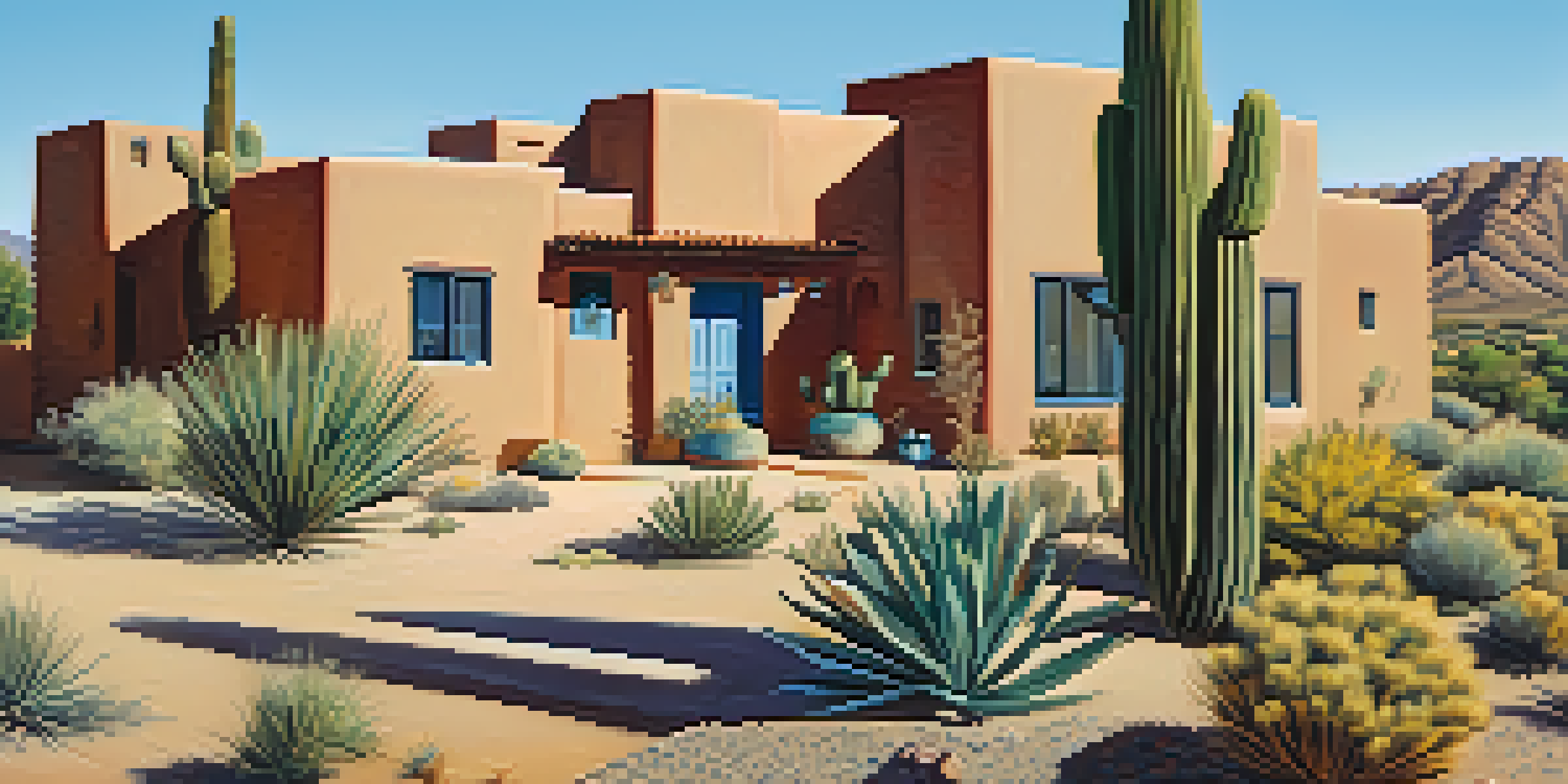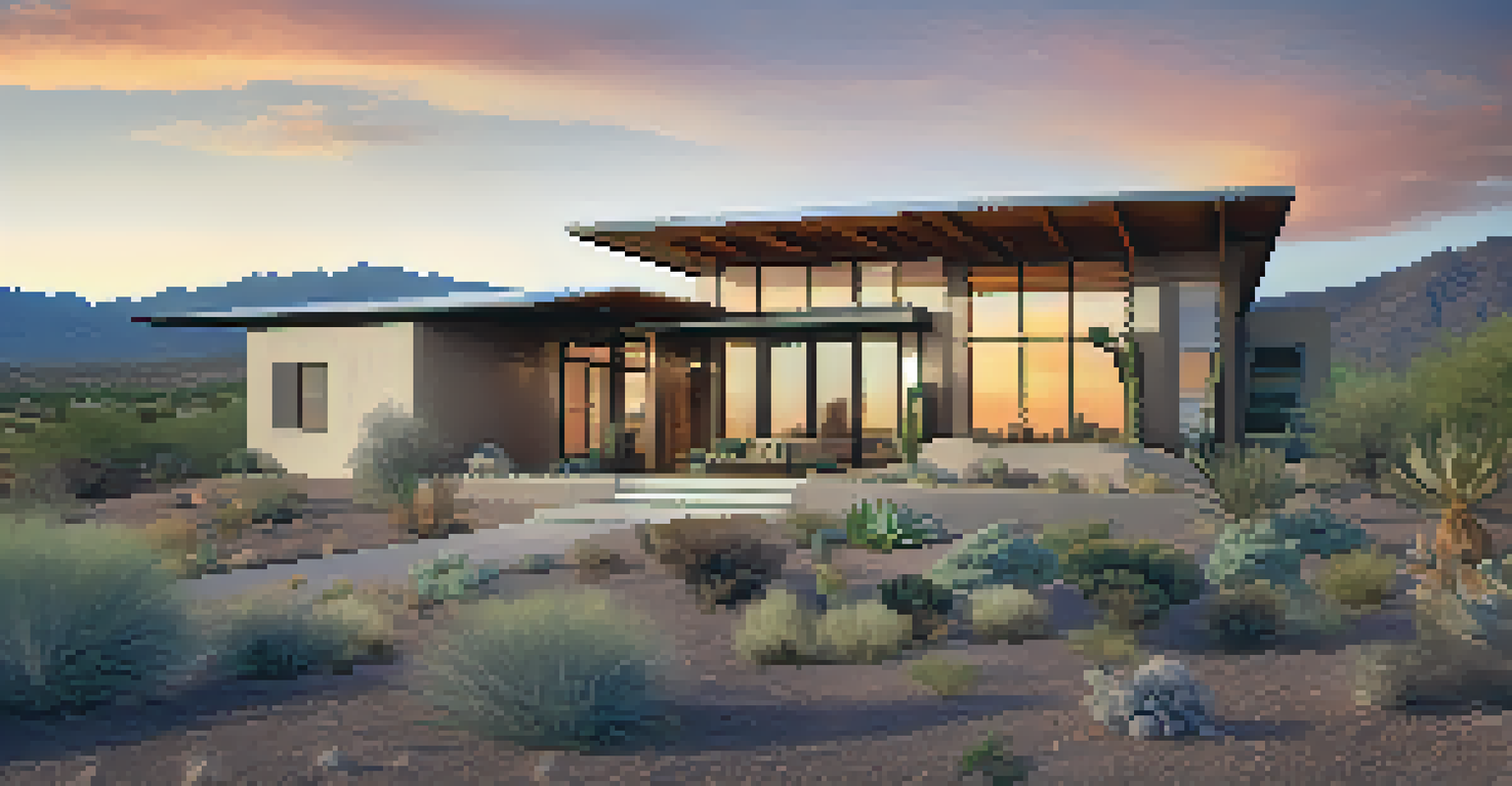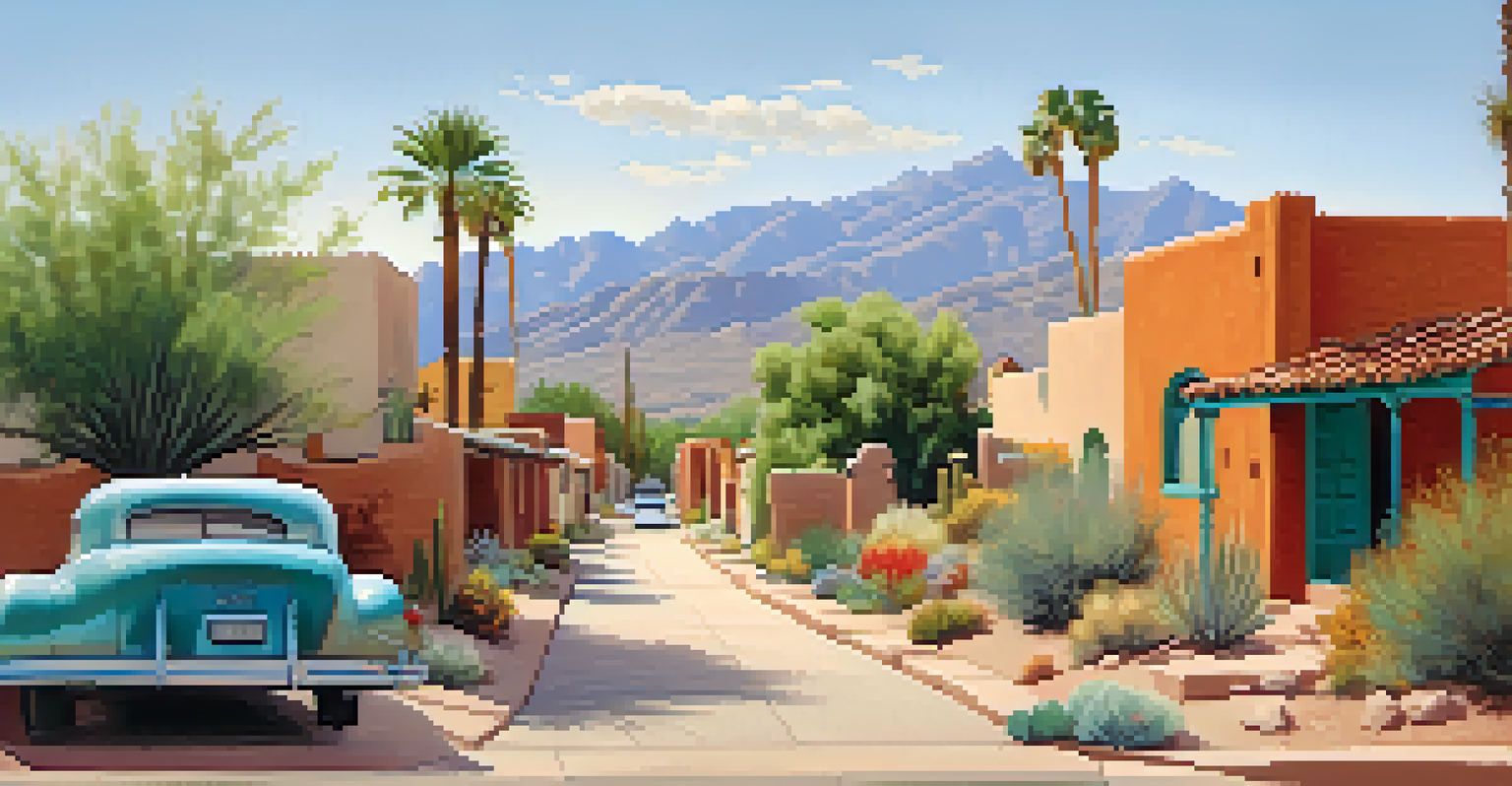Environmental Adaptations in Tucson's Architectural Styles

The Unique Climate of Tucson and Its Impact on Architecture
Tucson's desert climate, characterized by hot summers and mild winters, greatly influences its architectural designs. The need for energy efficiency and comfort drives homeowners and builders to adapt their structures accordingly. This means that traditional designs often incorporate features that naturally regulate indoor temperatures.
Architecture should be rooted in the local climate and culture, creating a dialogue between the built environment and nature.
For example, thick adobe walls are commonly used in Tucson homes to keep interiors cool during the scorching summer heat. These materials, known for their thermal mass, absorb heat during the day and release it at night, ensuring a stable indoor climate. Additionally, homes are often oriented to take advantage of prevailing breezes.
Ultimately, understanding Tucson's unique climate is essential for creating architecture that not only looks good but also functions effectively in harmony with the environment. This connection between climate and design is a key theme in many architectural styles found throughout the city.
Adobe Construction: A Historical Connection to the Environment
Adobe construction is one of the most iconic architectural styles in Tucson, deeply rooted in the region's history. Made from clay, sand, and straw, adobe bricks are not only sustainable but also provide excellent insulation against temperature fluctuations. These materials reflect the ingenuity of early settlers who learned to adapt to their environment using locally available resources.

In Tucson, adobe homes often feature flat roofs and thick walls, which help to regulate temperature and protect against the harsh sun. This style serves as a beautiful reminder of the city's rich cultural heritage, with many adobe buildings still standing strong today. These structures are not just homes; they are a testament to the adaptability of human design in response to environmental challenges.
Tucson's Climate Shapes Architecture
The desert climate of Tucson significantly influences architectural designs, promoting energy-efficient features to maintain indoor comfort.
Moreover, the continued use of adobe in modern construction showcases a blend of tradition and innovation, as contemporary builders incorporate modern amenities and design principles while maintaining the essence of this historical style.
Sustainable Practices in Modern Tucson Architecture
In recent years, there has been a significant shift towards sustainability in Tucson's architectural practices. Many new constructions incorporate green building techniques that reduce environmental impact while promoting energy efficiency. This trend is not only beneficial for the planet but also aligns with the values of a growing number of residents who prioritize eco-friendly living.
Sustainability is not a destination, but a journey of continual improvement and adaptation.
For instance, many designs now include features such as solar panels, rainwater harvesting systems, and natural landscaping that requires less water. These elements not only reduce utility costs but also help to preserve the local environment by minimizing resource consumption. Architects and builders are increasingly recognizing that modern technology can work hand-in-hand with traditional practices.
As Tucson continues to evolve, the commitment to sustainable architecture reflects a broader awareness of environmental issues and a dedication to preserving the region's beauty for future generations. This movement encourages a harmonious relationship between the built environment and the natural world.
The Role of Landscaping in Tucson's Architectural Aesthetic
Landscaping plays a crucial role in enhancing Tucson's architectural aesthetic, creating a seamless connection between buildings and their natural surroundings. Residents often choose native plants that thrive in the desert climate, reducing the need for excessive irrigation and maintenance. This approach not only conserves water but also supports local wildlife and biodiversity.
Desert landscaping techniques, such as xeriscaping, are becoming increasingly popular in Tucson. This method emphasizes the use of drought-resistant plants and materials that complement the natural landscape. By incorporating these elements, homeowners can create visually appealing outdoor spaces while remaining environmentally conscious.
Adobe Construction Reflects Heritage
Adobe construction in Tucson showcases sustainable practices and historical resilience, utilizing local materials to adapt to environmental challenges.
The thoughtful integration of landscaping with architectural design enhances the overall appeal of Tucson's neighborhoods, making them not only beautiful but also functional. This synergy between built and natural environments is a defining characteristic of Tucson's architectural identity.
Cultural Influences on Tucson's Architectural Diversity
Tucson’s architecture is a rich tapestry woven from diverse cultural influences, reflecting the city's unique history. From Native American to Spanish colonial styles, these influences are evident in the design and materials used throughout the city. This eclectic mix not only adds character to Tucson but also illustrates how different cultures have adapted to the desert environment.
For example, the Spanish Pueblo Revival style features stucco exteriors, tiled roofs, and decorative wrought iron, all designed to keep homes cool and welcoming. Similarly, elements of Native American architecture can be found in the use of natural materials and earth tones, creating a harmonious connection with the surrounding landscape. Each style tells a story of adaptation and resilience.
This architectural diversity enhances Tucson's appeal as a vibrant city, where the past and present coexist beautifully. This blend of cultural influences continues to inspire architects and designers, encouraging them to create spaces that honor the city’s heritage while meeting modern needs.
Energy Efficiency: Key Considerations for Tucson Homes
Energy efficiency is a priority for many Tucson residents, given the extreme heat during summer months. Builders and homeowners alike are increasingly seeking ways to reduce energy consumption through thoughtful design choices. This focus on efficiency not only lowers utility bills but also contributes to a more sustainable lifestyle.
One popular approach is the incorporation of large overhangs or shade structures that protect windows from direct sunlight, minimizing the need for air conditioning. Additionally, many homes now feature high-performance windows that reflect heat and retain cool air. These strategies highlight the importance of designing homes with the local climate in mind.
Sustainability Drives Modern Design
Current architectural trends in Tucson emphasize sustainability through smart technology and community-focused designs that foster eco-friendly living.
As a result, Tucson's homes are not just aesthetically pleasing; they are also built to withstand the challenges posed by their environment. The emphasis on energy efficiency reflects a growing awareness of the need for sustainable living in an ever-changing world.
Future Trends in Tucson's Architectural Landscape
As Tucson continues to grow and evolve, new architectural trends are emerging that reflect the city's commitment to sustainability and innovation. The integration of smart home technology is becoming increasingly common, allowing homeowners to control energy use and enhance comfort with ease. This trend signifies a shift towards a more connected and energy-efficient lifestyle.
Additionally, community-focused designs are gaining traction, with an emphasis on creating spaces that promote social interaction and collaboration. This includes mixed-use developments that combine residential, commercial, and recreational areas, fostering a sense of community while minimizing environmental impact. Such designs encourage walkability and reduce reliance on cars.

Looking ahead, Tucson's architectural landscape is set to embrace even more sustainable practices and innovative designs. As residents become increasingly aware of their environmental footprint, the city's architecture will continue to adapt, blending tradition and modernity in ways that honor Tucson's unique heritage.